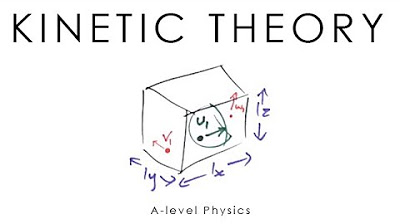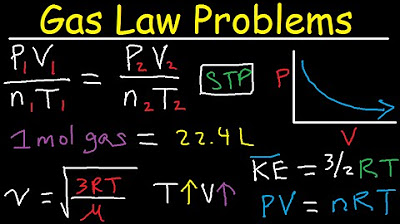Kinetic Molecular Theory
TLDRThis video script introduces the kinetic molecular theory, which explains the behavior of solids, liquids, and gases at a molecular level. It covers the properties of these states of matter, including their shape, volume, and kinetic energy. The script then focuses on ideal gases, simplifying the model by making assumptions like particles being hard spheres, no attraction between them, and perfectly elastic collisions, setting the stage for further exploration of gas behavior under varying pressure and temperature conditions.
Takeaways
- 📚 Kinetic molecular theory explains the states of matter (solid, liquid, gas) and their transformations.
- 🔬 The theory states that matter is made up of particles that are always moving.
- 🌡️ Kinetic energy is the energy of movement, determining the speed of particle motion.
- ❄️ In solids, particles are closely packed in an ordered, crystalline structure with low kinetic energy, having a definite shape and volume.
- 💧 In liquids, particles have higher kinetic energy, move randomly, and can flow past one another, with a definite volume but an indefinite shape.
- 💨 In gases, particles have very high kinetic energy, move very rapidly and randomly, with no definite shape or volume.
- ⚛️ Intermolecular forces are the attractions between particles, influencing their state and movement.
- 🔍 Ideal gas assumptions include particles being hard round spheres, not attracting each other, not taking up space, and having perfectly elastic collisions.
- 🧪 Ideal gases are simplified models used to understand gas behavior under different conditions of pressure and temperature.
- 🚀 The study of ideal gases lays the groundwork for understanding real gases, which are more complex.
Q & A
What is kinetic molecular theory?
-Kinetic molecular theory is a scientific theory used to describe the states of matter (solid, liquid, and gas) and how they transform into one another. It explains the behavior of particles in different states of matter.
What are the two main parts of kinetic molecular theory?
-The first part states that matter is made up of particles, and the second part states that these particles are always moving.
How do particles behave in a solid according to kinetic molecular theory?
-In a solid, particles are arranged in a nice ordered pattern called a crystal structure. They vibrate in place with low kinetic energy, and solids have a definite shape and volume.
What distinguishes the behavior of particles in a liquid from those in a solid?
-In a liquid, particles have greater kinetic energy, move randomly, and can flow past one another. Liquids have an indefinite shape, taking on the shape of their container, but they have a definite volume.
How do gas particles behave differently from liquid and solid particles?
-Gas particles move very quickly and randomly with high kinetic energy. They are very spread out, have an indefinite shape, and an indefinite volume, meaning they can fill the shape and volume of their container.
What is kinetic energy and how does it relate to particle movement?
-Kinetic energy is the energy of movement. The more kinetic energy a particle has, the faster it will move. Conversely, less kinetic energy means slower movement.
What are intermolecular forces and how do they affect particles in different states of matter?
-Intermolecular forces are the forces of attraction between molecules. In solids, these forces keep particles in a fixed pattern. In liquids, particles have enough energy to move past one another but not enough to completely break these forces. In gases, particles move so quickly that intermolecular forces have little to no effect.
Why do we study ideal gases instead of real gases in kinetic molecular theory?
-Ideal gases are simpler to study because they allow us to make certain assumptions that ignore the complexities of real gases. This simplification helps in understanding gas behavior under different conditions.
What are the four main assumptions made about ideal gases?
-The four main assumptions are: 1) Gas particles are hard, round spheres, 2) Gas particles are not attracted to one another, 3) Gas particles do not take up any space themselves, and 4) Gas particles collide perfectly elastically.
How does kinetic molecular theory explain the behavior of gas particles under different conditions of pressure and temperature?
-Kinetic molecular theory explains that gas particles move faster with increased temperature, increasing their kinetic energy. Under higher pressure, particles are forced closer together, which can affect their movement and behavior.
Outlines
🔬 Introduction to Kinetic Molecular Theory
This paragraph introduces the concept of kinetic molecular theory, a scientific framework that explains the states of matter—solid, liquid, and gas—and their transformations. The video aims to provide a molecular-level visualization of these states, focusing on their shape, volume, and kinetic energy. The theory posits that matter is composed of particles that are in constant motion, with kinetic energy being the energy of movement. The more kinetic energy a particle has, the faster it moves. The paragraph also introduces the idea of intermolecular forces, which are the attractive forces between molecules. It uses the example of an ice cube to illustrate the structure and properties of solids, highlighting their ordered pattern, low kinetic energy, and definite shape and volume.
💧 Understanding Liquids and Gases
The second paragraph delves into the behavior of liquids and gases. In liquids, particles have higher kinetic energy, allowing them to move more freely and randomly, though not enough to overcome intermolecular forces. This results in liquids having no definite shape, taking the shape of their container, but maintaining a definite volume. The discussion then shifts to gases, where particles move so quickly that intermolecular forces are negligible. Gases lack both a definite shape and volume, capable of expanding to fill available space or being compressed. The paragraph concludes with an introduction to ideal gases, a simplified model that assumes gas particles are hard spheres, not attracted to each other, do not occupy space, and collide elastically. These assumptions are foundational for the subsequent lessons in the series on gases.
Mindmap
Keywords
💡Kinetic Molecular Theory
💡Kinetic Energy
💡Intermolecular Forces
💡Solid
💡Liquid
💡Gas
💡Ideal Gas
💡Elastic Collision
💡Crystalline Structure
💡Volume
💡Shape
Highlights
Kinetic Molecular Theory is a scientific theory used to describe the states of matter and their transformations.
The theory visualizes solids, liquids, and gases at the molecular level.
It defines matter as being made up of particles that are always moving.
Kinetic energy is the energy of movement, with faster particles having more kinetic energy.
Solids have particles with low kinetic energy, vibrating in place with an ordered crystalline structure.
Solids maintain a definite shape and volume due to intermolecular forces.
Liquids have particles with greater kinetic energy, moving randomly but not enough to break attractive forces.
Liquids do not have a definite shape, conforming to the shape of their container, but maintain a definite volume.
Gas particles move very quickly, with attractive forces having almost no effect.
Gases have an indefinite shape and volume, able to be compressed or expanded.
The series will focus on ideal gases, simplifying the model by making certain assumptions.
Assumptions include gas particles being hard round spheres, not attracted to each other, and not taking up space.
Gas particles are assumed to collide perfectly elastically, transferring kinetic energy between them.
The kinetic molecular theory lays the groundwork for understanding gases under various pressure and temperature conditions.
The theory helps to understand the behavior of gases by describing the amount of kinetic energy particles possess.
Real gases are more complex, so the study focuses on ideal gases for simplicity.
The assumptions guide our understanding of gases and their behavior in the subsequent lessons.
Transcripts
Browse More Related Video

9.1 Pressure and Kinetic Molecular Theory of Gases | High School Chemistry

States of Matter : Solid Liquid Gas

Kinetic Molecular Theory of Gases - Practice Problems

Kinetic Theory of Gases - A-level Physics

Ideal gas equation: PV = nRT | Chemistry | Khan Academy

Gas Law Problems Combined & Ideal - Density, Molar Mass, Mole Fraction, Partial Pressure, Effusion
5.0 / 5 (0 votes)
Thanks for rating: